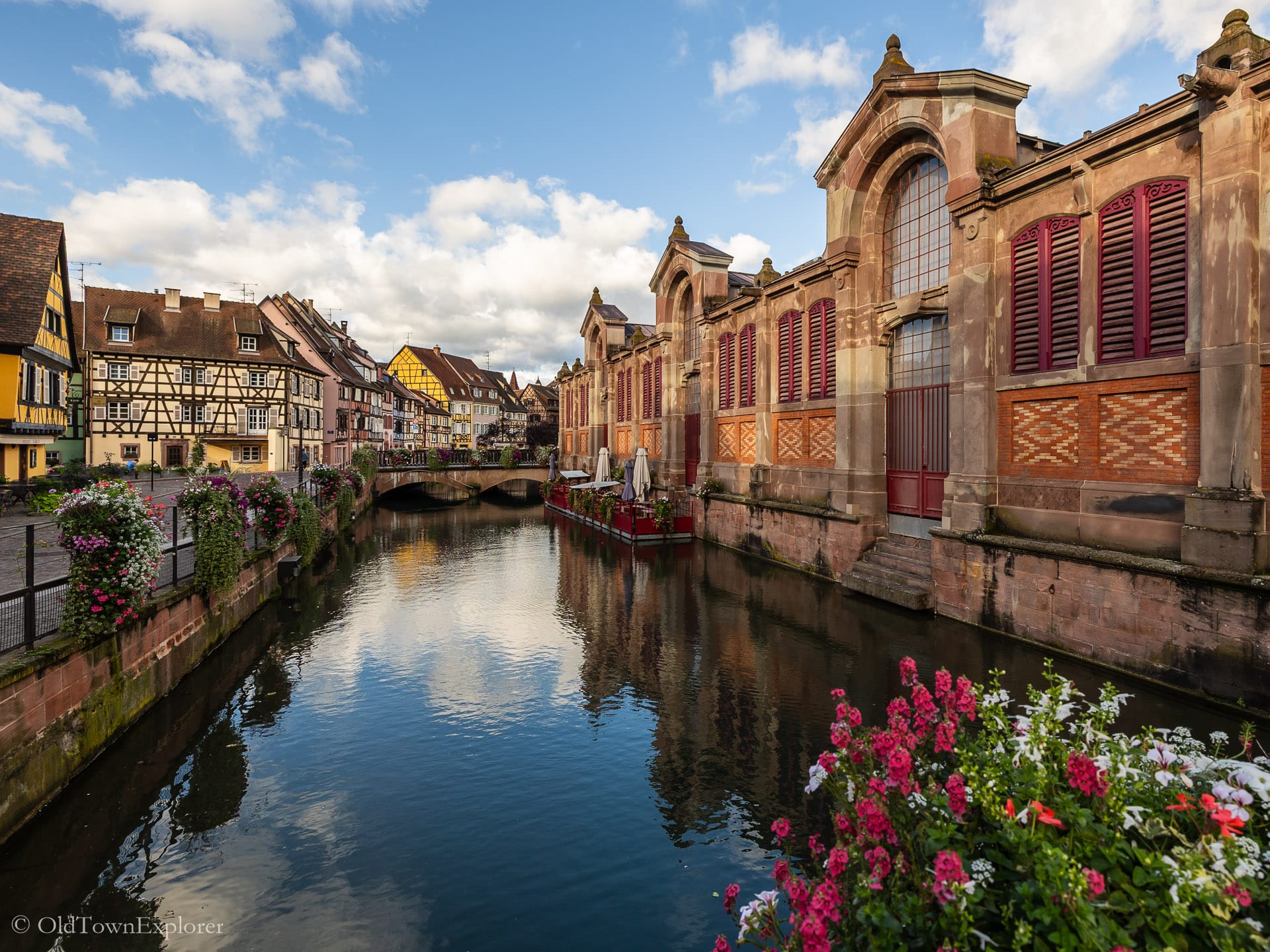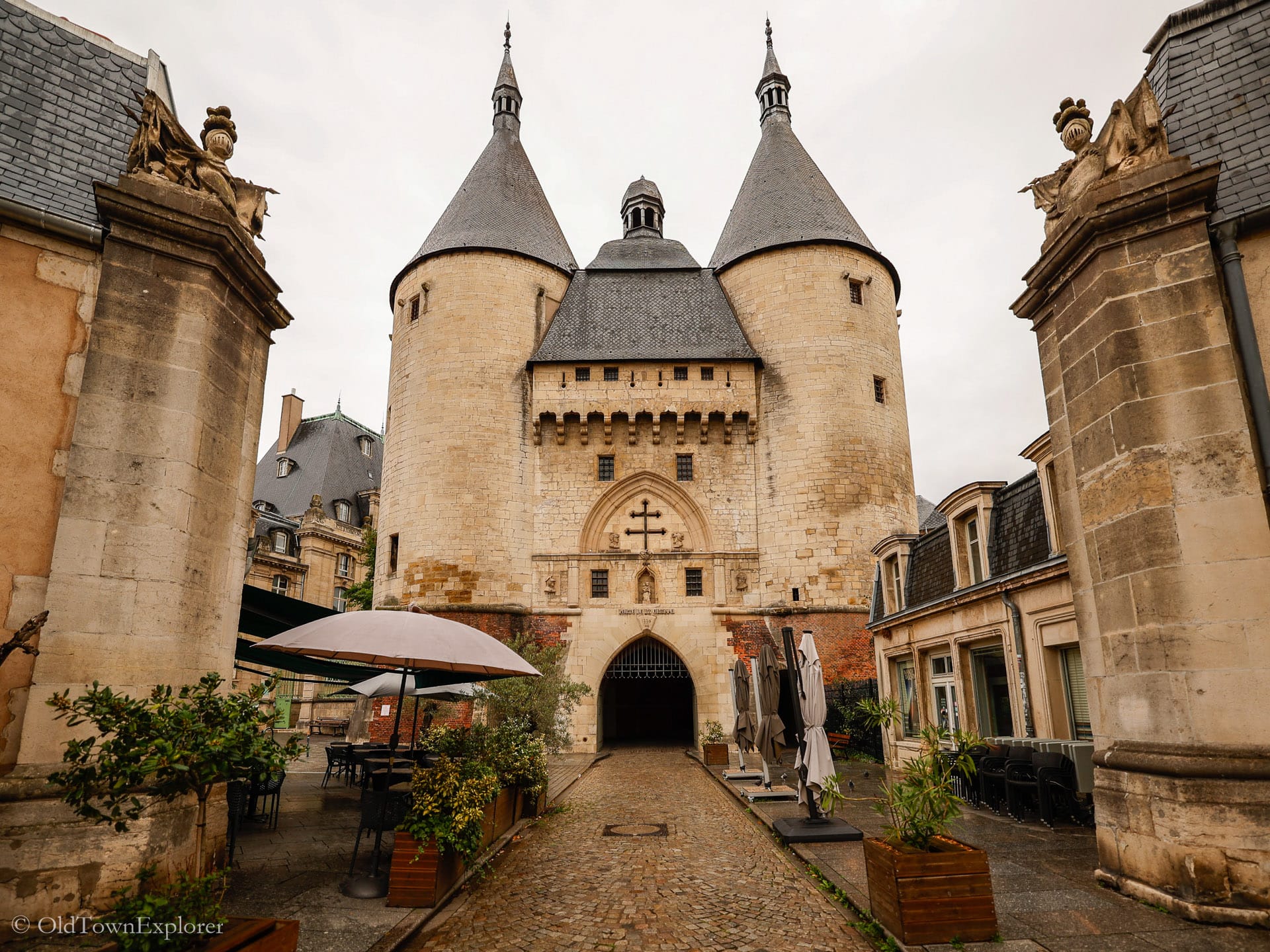Strasbourg
Food | Wine | ArchitectureExplore Strasbourg: Food, Wine & Architecture
Strasbourg is one of France’s most visually and culturally compelling cities, where Gothic cathedrals rise above timber-framed houses and canals wind through a UNESCO-listed Old Town.
Often referred to as “the crossroads of Europe,” Strasbourg is a blend of French elegance with German heritage. The city offers a rich tapestry of architecture, from medieval quarters to 19th-century boulevards.
Food lovers will find traditional Alsatian dishes served in historic winstubs, while wine enthusiasts can sample aromatic whites from nearby vineyards along the Alsace Wine Route.
Below is our guide to what to eat, drink, and see in Strasbourg—plus tips for when to go, where to stay, and how to make the most of your visit.
This website contains affiliate links that may earn us a small commission at no additional cost to you.
Strasbourg Food
Strasbourg’s food scene is deeply rooted in Alsatian tradition, offering a mix of French and German influences that make it one of France’s most distinctive culinary destinations. Travelers can expect hearty dishes like choucroute garnie, baeckeoffe, and tarte flambée, often served in cozy winstubs—local taverns that specialize in regional fare.
Beyond traditional restaurants, Strasbourg also boasts vibrant food markets and gourmet shops where visitors can explore local cheeses, charcuterie, and seasonal produce.
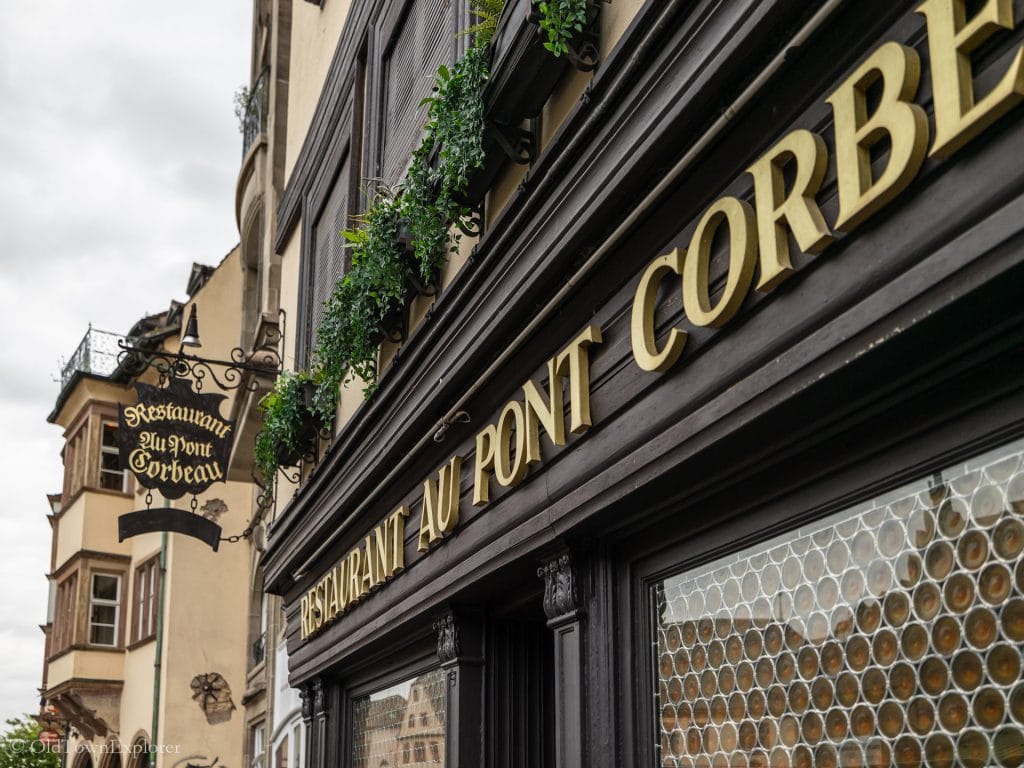
Strasbourg Wine
Strasbourg is a gateway to the Alsace Wine Route, one of France’s most celebrated wine regions known for its aromatic whites like Riesling, Pinot Gris, and Gewürztraminer. Though vineyards lie just beyond the city, Strasbourg itself is steeped in wine culture, with plenty of ways for visitors to explore local bottles.
Wine bars and winstubs across the city serve regional wines by the glass, while specialty shops offer curated selections perfect for tasting or taking home.
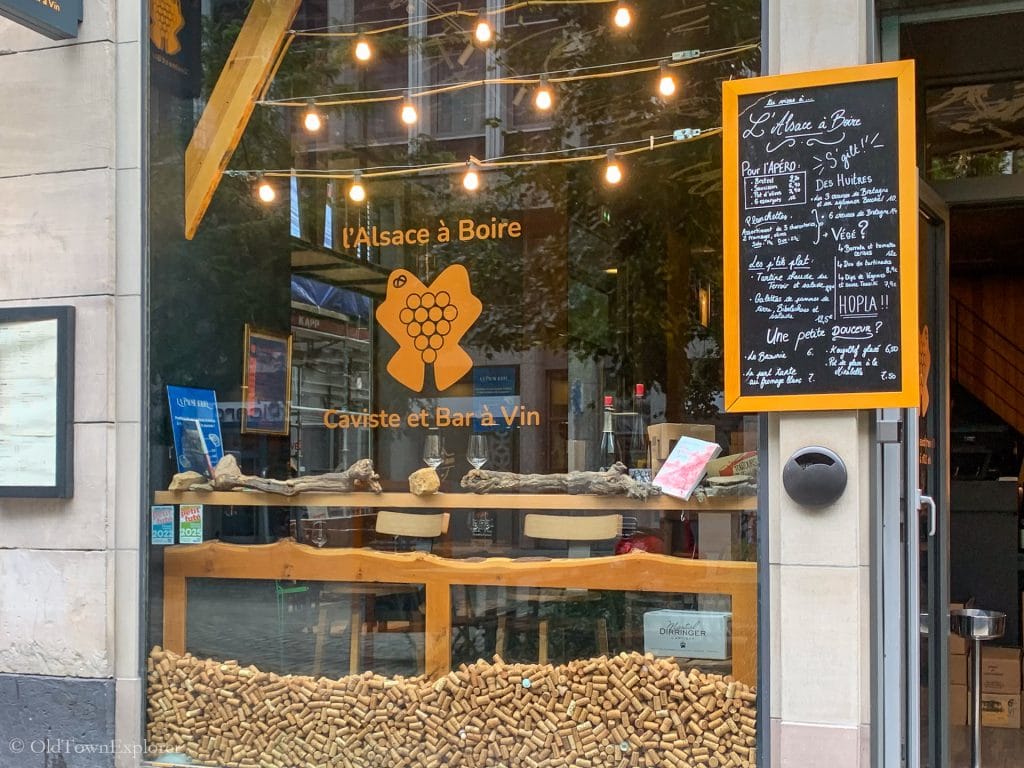
Strasbourg Architecture
Strasbourg’s Old Town, a UNESCO World Heritage Site, is a showcase of architectural history, with styles ranging from medieval to Renaissance and beyond. Narrow cobblestone streets wind through timber-framed houses, canal-side buildings, and stone bridges that reflect the city’s past as a cultural crossroads. Towering above it all is Strasbourg Cathedral, a Gothic masterpiece with intricate carvings and an astronomical clock.
From the charming facades of La Petite France to the stately public buildings in the Neustadt district, Strasbourg’s architecture is both visually striking and deeply rooted in its layered history.
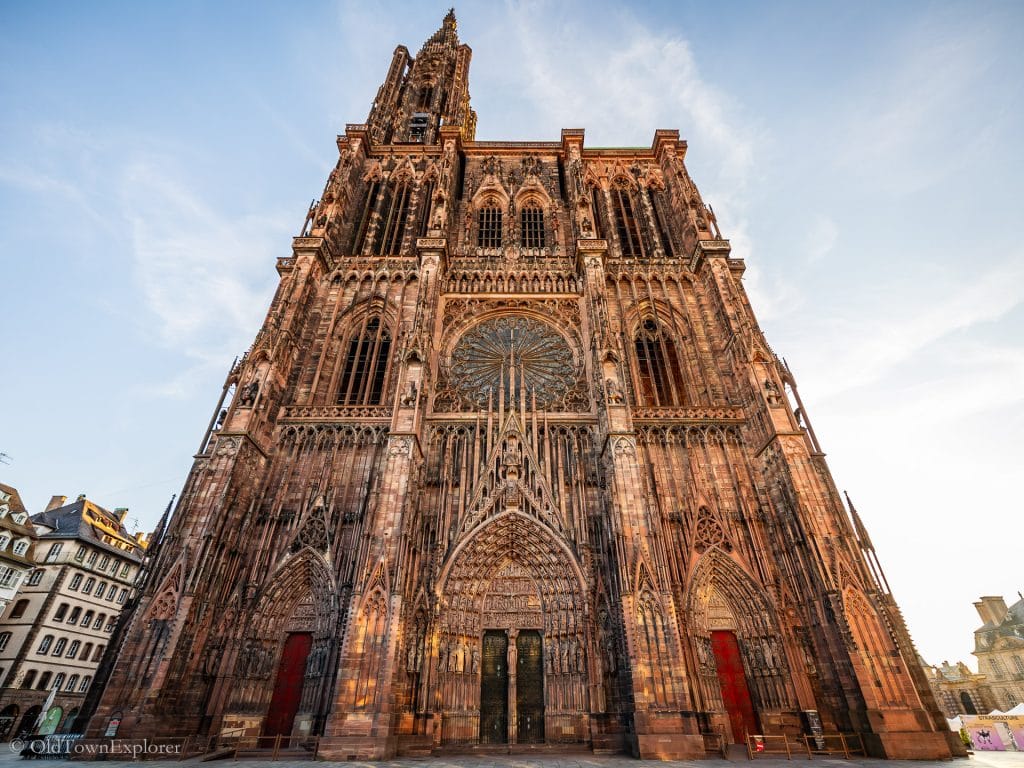
Where Is Strasbourg Located?
Strasbourg is located in northeastern France, near the German border, in the Grand Est region. The city sits on the Ill River and is connected to the Rhine, with a network of canals running through its historic center.
When Is The Best Time To Visit Strasbourg?
The best time to visit Strasbourg is during spring (April to June) and early fall (September to October), when the weather is mild and ideal for walking along the city’s canals and exploring its historic quarters. These shoulder seasons offer a balance of comfortable temperatures, lighter tourist crowds, and better hotel rates compared to the busy summer months.
Weather
The best weather is a personal preference. We find the best weather for exploring a city is around 55°F and sunny. The weather in Strasbourg during the winter can be cold, so plan accordingly if you’re visiting for the Christmas Holiday.
Below is a chart showing the average high and low temperatures for each month, so you can decide what is best for you.

Shoulder Season
Strasbourg’s shoulder seasons—spring (April to June) and early fall (September to October)—offer mild weather, thinner crowds, and better prices, making them ideal for sightseeing and enjoying the city’s markets and riverside walks.
We spent the entire month of September in Strasbourg. The weather was cool in the morning but warmed up during the day.
Best Value
For the best value, visit Strasbourg in April or October, when hotel rates are lower and the city is less crowded. These months still offer pleasant weather, making it easy to explore the Old Town and enjoy the local food scene without peak-season prices.
Best Places to Stay In Strasbourg
Hotels in Strasbourg
For travelers seeking atmosphere, walkability, and historic charm, the Petite France neighborhood is the best place to stay in Strasbourg. This central district, part of the UNESCO-listed Old Town, is known for its half-timbered houses, cobblestone lanes, and canal-side views. Many hotels here occupy restored historic buildings and offer direct access to top attractions like Strasbourg Cathedral and the Covered Bridges. Staying in Petite France means you’re within easy walking distance of restaurants, shops, and tram stops, making it ideal for first-time visitors and anyone interested in architecture, food, and riverside ambiance.
Use the interactive map below to explore accommodations by date, budget, and amenities. Book your stay now!
Other Things to Know About Strasbourg
Airport
The principal airport serving Strasbourg is Strasbourg‑Entzheim Airport (IATA: SXB). Located in Entzheim about 10 km (6 mi) southwest of the city, it offers regional international connections and handles primarily European traffic.
Travelers can reach central Strasbourg by TER regional train—the journey takes around 9–12 minutes, or by car or taxi in approximately 12 to 20 minutes depending on traffic.
Train Station
The main train station in Strasbourg is known as Gare de Strasbourg-Ville (often simply “Strasbourg” or “Strasbourg-Ville”). It occupies a historicist-style building, reconstructed in 1883 and enhanced in 2007 with an impressive glass canopy over its facade. In 2023, it handled nearly 24 million passengers, making it one of France’s busiest stations outside the Paris region.
Situated on the western edge of the Old Town, the station lies within walking distance of Strasbourg’s historic district. Visitors can reach La Petite France in around 10–15 minutes on foot. For faster travel, trams A and D run from the underground tram stop directly beneath the station to stops near the cathedral and central squares.
Time Zone
Strasbourg is in the Central European Time zone (CET = UTC +1). Daylight saving time applies from the last Sunday in March to the last Sunday in October, during which the city observes Central European Summer Time (CEST = UTC +2).
Currency
Euro (€)
Language
French is the official language in Strasbourg, though German is also commonly understood. English is widely spoken in tourist areas, restaurants, and hotels.
Visa
Citizens from the United States, United Kingdom, Canada, and Australia don’t need a visa to visit France for stays of up to 90 days within a 180-day period. France is part of the Schengen Area, so this rule applies to travel across most of continental Europe. For more information on visa-free travel in France, check out our article on traveling visa-free.
Electricity
France uses electrical outlets of Type C and Type E. Type C has two round pins, while Type E includes two round pins and a hole for the socket’s male grounding pin. The standard voltage is 230V with a frequency of 50Hz.
Travelers from the United States and other countries using different plug types or voltages will need an adapter, and possibly a voltage converter. A travel power strip with USB ports can be useful, allowing multiple devices to charge from a single outlet using one adapter.
SIM Card
Travelers will want a SIM card for France. You can get either a local SIM card or an eSIM card.
To get a local SIM card, you must find a local cellular service provider, often stand in line for assistance, show your passport, and complete some paperwork. The SIM cards work great, but purchasing them is somewhat inconvenient. This option is best if you need more than 5GB of data.
We use eSIMs exclusively because they can be purchased before arrival in a new country and activated when you hit a cell tower in the country. We use Airalo eSIMs. They work great, and I recommend them if you plan to use less than 5 GB of data during your stay or if you need internet immediately on arrival.
Car Rental
The lack of a train system in France makes rental cars necessary for most destinations. In addition to the major car rental companies found in the United States, Sixt and Europcar are common throughout Europe. For a comparison of rental car offers from large international brands and smaller regional brands, we recommend Discover Cars.
FAQs About Strasbourg
What is the population of Strasbourg?
Strasbourg has a population of approximately 290,000 residents, making it one of the largest cities in northeastern France. The greater Strasbourg metropolitan area is home to over 500,000 people, and the city plays a key role as both a cultural and political hub in Europe.
What are the top things to do in Strasbourg?
Top things to do in Strasbourg include visiting Strasbourg Cathedral with its astronomical clock, exploring the half-timbered houses of La Petite France, and walking along the canals in the historic Old Town. Don’t miss a boat tour of the Ill River, local food at a traditional winstub, and the European Parliament buildings.
What is the most beautiful village near Strasbourg?
Eguisheim is widely considered one of the most beautiful villages near Strasbourg. Located about 75 km south, it’s known for its circular layout, cobblestone streets, and brightly painted half-timbered houses. Eguisheim is also part of the Alsace Wine Route and ideal for day trips.
Is Strasbourg worth visiting?
Yes, Strasbourg is absolutely worth visiting. Its UNESCO-listed Old Town, Gothic cathedral, canals, and unique mix of French and German culture make it one of France’s most distinctive cities. Whether you’re interested in architecture, food, or history, Strasbourg offers something for every traveler.
What food is Strasbourg famous for?
Strasbourg is famous for Alsatian dishes like tarte flambée (flammekueche), choucroute garnie (sauerkraut with sausages and meats), and baeckeoffe (a hearty meat and potato stew). The city’s food scene reflects a mix of French and German culinary traditions, especially in cozy winstubs serving local specialties.
Where can you eat traditional Alsatian food in Strasbourg?
To eat traditional Alsatian food in Strasbourg, visit local winstubs such as Winstub S’Kaechele, Maison Kammerzell, or Le Clou. These taverns offer regional classics in historic settings, often featuring timber-framed interiors and canal views near the Old Town.
What wines are produced near Strasbourg?
Strasbourg is located near the Alsace Wine Route, which produces aromatic white wines such as Riesling, Gewürztraminer, Pinot Gris, and Muscat. These wines are known for their floral notes, crisp acidity, and perfect pairing with Alsatian cuisine.
Can you visit wineries near Strasbourg?
Yes, several wineries near Strasbourg offer tastings and tours, especially in villages like Obernai, Barr, and Eguisheim. Many are located along the Alsace Wine Route and can be visited on guided day trips or self-organized tours by car or bike.
What architectural styles can you see in Strasbourg?
Strasbourg features a mix of Gothic, Renaissance, Baroque, and half-timbered Alsatian architecture. Key sites include Strasbourg Cathedral (Gothic), the Kammerzell House (Renaissance), and the pastel-colored buildings of La Petite France. The city also includes 19th-century Prussian architecture in the Neustadt district.
Strasbourg Blog Posts
Want more details about life in Strasbourg? Check out our in-depth blog posts:
Explore Colmar, France
Discover Colmar, France. Learn about its half-timbered houses, Gothic churches, canal-side districts, and how to plan your visit.
Explore Nancy, France
Discover Nancy, France. Learn about its UNESCO-listed squares, Art Nouveau landmarks, and centuries of history in this architectural guide.

